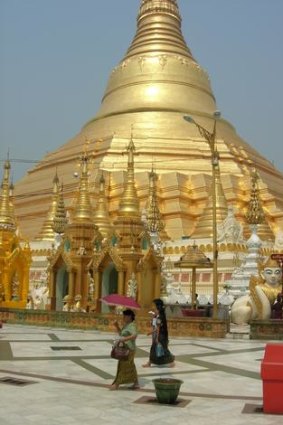This was published 12 years ago
From the sodden seaside of Britain to the quietly glittering jewel of Burma
Exploring a land where few tourists visit has become an enthralling habit.
By Graham Reilly
I'VE HAD some really rotten holidays. They mostly involved driving from Glasgow to some psychosis-inducing seaside town in Lancashire at the height of the British summer. It would rain every other day and, in between, the heavy grey-worsted clouds would hang around like an axe murderer having a fag on a dank street corner.
Every year my parents would stuff their three sons into a 1963 Ford Anglia and head down to Blackpool, Morecambe or Whitley Bay. It was like a war zone in the Anglia, with my carsick brothers and I vomiting up packets of salt and vinegar chips and an assortment of Cadbury's chocolate bars.

Burma has an extraordinary array of temples.Credit: Gary Munro
Then I grew up and discovered Burma. I first went there in 2007. I was living in Delhi and, sick of the oppressive heat there, I thought I'd go and experience the oppressive heat elsewhere. I considered the argument that going there amounted to condoning the venal military dictatorship, but I decided that spending money where it would benefit local people was the better choice for me.
And it proved to be the right one. Walking around Rangoon on my first day was like opening a creaky door to a world that had been closed for a long time. I found a city of gloriously decrepit grandeur, where some polished jewels of British colonial architecture sat side by side with rotting remnants of a prosperous past when Burma was the rice bowl of Asia and a key administrative centre of the Raj. There were few cars on the streets, and the crumbling pavements were a crush of tea shops and market stalls. Buddhist monks seemed to float past, shaven-headed and clad diaphanously in orange or pink robes.
Rangoon is home to two great temples, including the most sacred site in Burma, the 1000-year-old Shwedagon Paya, which in 1889 Rudyard Kipling described as ''a golden mystery [that] upheaved itself on the horizon, a beautiful winking wonder that blazed in the sun''. Indeed, there are so many temples in Burma it is easy to get temple-stroke.
The town of Bagan in central Burma has such an extraordinary array of Buddhist temples dating from the 11th century that it would take four or five days to visit them all. It is one of the wonders of the world and a ''must-see'' for American tour groups. In a place where locals still get about by horse and cart I overheard one American complain that there was no wi-fi in her hotel room.
On my second trip to Burma, in January 2010, I headed north to Mandalay, a dusty and raggedy city that doesn't live up to the romance of its name. But nearby are some of the country's ancient royal capitals, including Amarapura, best known for its 1200-metre-long teak footbridge across the Taungthaman lake.
In Mandalay I was eating dinner at an outdoor Indian restaurant when a German backpacker who had ordered curried chicken asked the waiter a question that clearly puzzled him.
''Are there any splinters in the chicken?''
''Splinters?'' the waiter politely replied.
''Yes,'' the customer said earnestly. ''Sometimes the bones, they are getting chopped up and it is difficult for me in my throat.''
The waiter managed to alloy a sigh and a smile. ''No sir, the chicken has no splinters.''
Unless you fly to major tourist centres - such as they are - getting around Burma is often uncomfortable and time-consuming. I took a share-taxi to Pyin U Lwin, a former British hill station north-east of Mandalay, with its lovely botanic gardens, grand old mansions and roads that can only be described as completely stuffed. From there I boarded the toy-like train for the trip to Hsipaw, a quiet mountain town in Shan state.
As it prepared to leave the station it sneezed, burped, clicked and rumbled. ''Our train, we call it the buffalo train,'' the station-master explained ''It is moving very slowly.''
In Hsipaw I saw just one other tourist; this can often be the case in Burma. I always arrive there with a great sense of excitement about what I will see, or who I will meet. Just being there is almost enough.
Despite the extremely difficult conditions in which people live, they are friendly and warm, and still regard visitors with pleasure rather than suspicion or disdain.
I will be there again in a couple of weeks to take a long, slow boat ride up the Thanlwin River from Mawlamyine to Hpa-An. The place names alone make me want to get there as soon as I can.